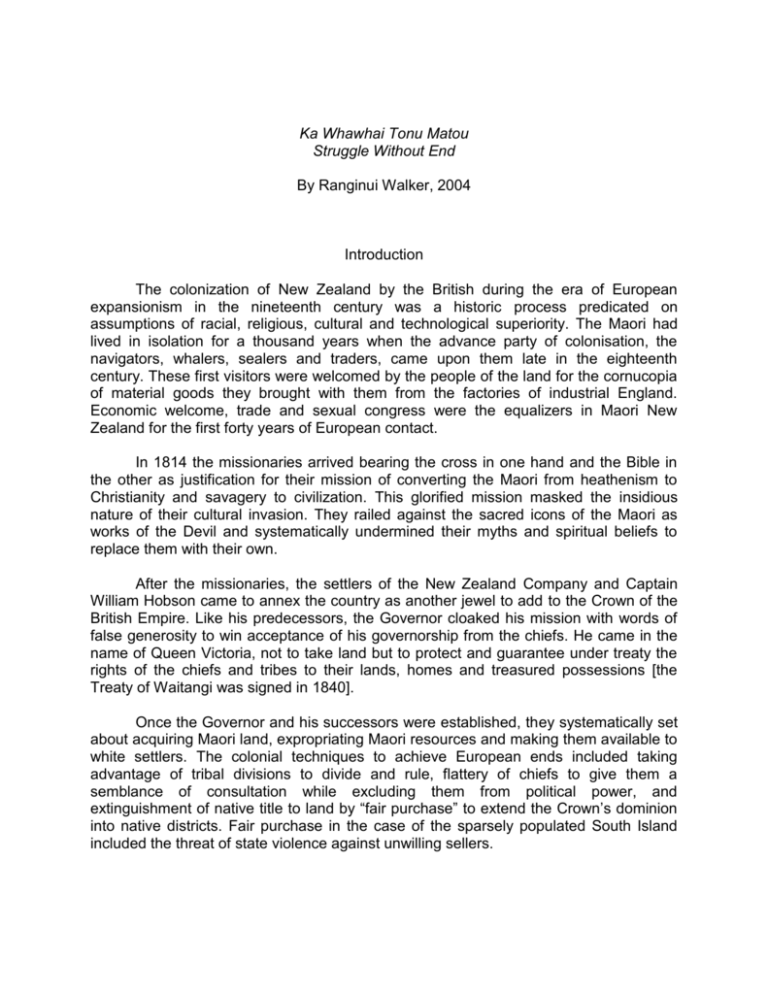Introduction
advertisement

Ka Whawhai Tonu Matou Struggle Without End By Ranginui Walker, 2004 Introduction The colonization of New Zealand by the British during the era of European expansionism in the nineteenth century was a historic process predicated on assumptions of racial, religious, cultural and technological superiority. The Maori had lived in isolation for a thousand years when the advance party of colonisation, the navigators, whalers, sealers and traders, came upon them late in the eighteenth century. These first visitors were welcomed by the people of the land for the cornucopia of material goods they brought with them from the factories of industrial England. Economic welcome, trade and sexual congress were the equalizers in Maori New Zealand for the first forty years of European contact. In 1814 the missionaries arrived bearing the cross in one hand and the Bible in the other as justification for their mission of converting the Maori from heathenism to Christianity and savagery to civilization. This glorified mission masked the insidious nature of their cultural invasion. They railed against the sacred icons of the Maori as works of the Devil and systematically undermined their myths and spiritual beliefs to replace them with their own. After the missionaries, the settlers of the New Zealand Company and Captain William Hobson came to annex the country as another jewel to add to the Crown of the British Empire. Like his predecessors, the Governor cloaked his mission with words of false generosity to win acceptance of his governorship from the chiefs. He came in the name of Queen Victoria, not to take land but to protect and guarantee under treaty the rights of the chiefs and tribes to their lands, homes and treasured possessions [the Treaty of Waitangi was signed in 1840]. Once the Governor and his successors were established, they systematically set about acquiring Maori land, expropriating Maori resources and making them available to white settlers. The colonial techniques to achieve European ends included taking advantage of tribal divisions to divide and rule, flattery of chiefs to give them a semblance of consultation while excluding them from political power, and extinguishment of native title to land by “fair purchase” to extend the Crown’s dominion into native districts. Fair purchase in the case of the sparsely populated South Island included the threat of state violence against unwilling sellers. In the more populous North Island the chiefs organized to resist subjection by the settler government. When the General Assembly met for the first time in 1854, sagacious leaders such as Wiremu Tamihana sought Maori admission into the Assembly. When that was denied, he pressed for a council of chiefs to advise the Governor on Maori policy. Then even that level of participation in the administration was denied, Tamihana put his talents to work for the election of a Maori King. His response to the dual world of the colonized and the coloniser was to form a conjoint administration coexisting under the mantel of Queen. The Governor would not countenance coexistence so he made war on the Maori King to assert the sovereignty of the Crown. The settler government took advantage of the conflict by making laws in Parliament, where Maori had no representation, to take land by confiscation, and later by legal artifices through the Native Land Court. The outcome of colonization by the turn of the century was impoverishment of the Maori, marginalisation of elders and chiefly authority and a structural relationship of Pakeha dominance and Maori subjection. So total was Pakeha dominance at a time when the Maori population had fallen to its lowest point of 45,549, that the colonizer deluded himself into thinking he had created a unified nation state of one people whereby amalgamation of the races would resolve once and for all the problem of the Maori. The coloniser had not taken into account the resilience of human nature. The Maori population recovered and grew exponentially within three generations to its present level of over 404,185. This growth was accompanied by a cultural renaissance and a demographic shift of 75 percent of the Maori population to towns and cities after the Second World War. As portended by the freedom fighters at Orakau that the struggle against an unjust social order would go on forever, the urban Maori have taken up where their forebears left off. This book is about the endless struggle of the Maori for social justice, equality and self-determination, whereby two people can live as coequals in the post-colonial era of the new nation state in the twenty-first century.








